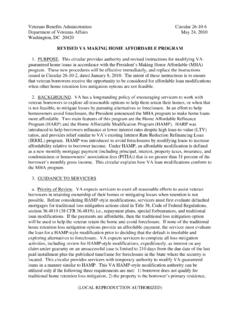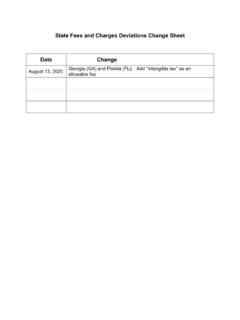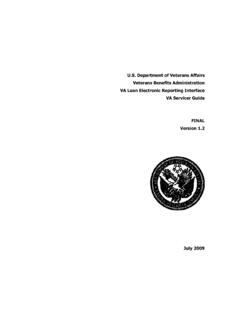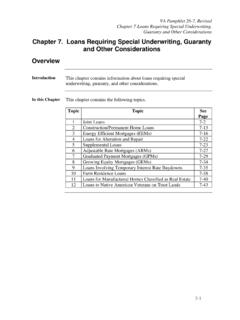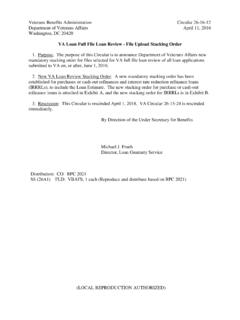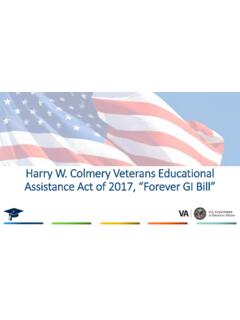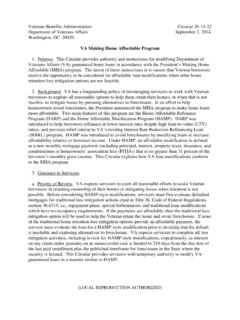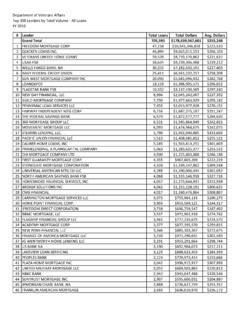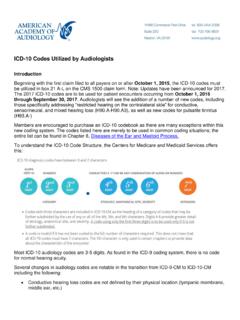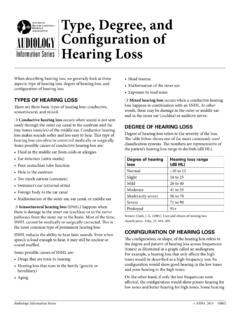Transcription of Audio Examination - Veterans Benefits Administration Home
1 Audio Examination Name: SSN: Date of Exam: C-number: Place of Exam: The Handbook of Standard Procedures and Best Practices for Audiology Compensation and Pension Exams is available online. ( This is a PDF file. You need Acrobat Reader to open pdf files. It is a free download. ). Narrative: An Examination of hearing impairment must be conducted by a state- licensed audiologist and must include a controlled speech discrimination test (specifically, the Maryland CNC recording) and a pure tone audiometry test in a sound isolated booth that meets American National Standards Institute standards (ANSI 1991) for ambient noise. Measurements will be reported at the frequencies of 500, 1000, 2000, 3000, and 4000 Hz.
2 The Examination will include the following tests: Pure tone audiometry by air conduction at 250, 500, 1000, 2000, 3000, 4000, and 8000 Hz, and by bone conduction at 250, 500, 1000, 2000, 3000, and 4000 Hz, spondee thresholds, speech recognition using the recorded Maryland CNC Test, tympanometry and acoustic reflex tests, and, when necessary, Stenger tests. Bone conduction thresholds are measured when the air conduction thresholds are poorer than 15 dB HL. A modified Hughson- Westlake procedure will be used with appropriate masking. A Stenger must be administered whenever pure tone air conduction thresholds at 500, 1000, 2000, 3000, and 4000 Hz differ by 20 dB or more between the two ears.
3 Maximum speech recognition will be reported with the 50 word VA approved recording of the Maryland CNC test. The starting presentation level will be 40 dB re SRT. If necessary, the starting level will be adjusted upward to obtain a level at least 5. dB above the threshold at 2000 Hz, if not above the patient's tolerance level. The Examination will be conducted without the use of hearing aids. Both ears must be examined for hearing impairment even if hearing loss in only one ear is at issue. When speech recognition is 92% or less, a performance intensity function must be obtained. Procedures for Obtaining a Modified Performance-Intensity Function 1. The starting level is 40 dB re: SRT (speech reception threshold).
4 The starting level will be adjusted upward to obtain a level at least 5 dB above the threshold at 2000 Hz, if not above the patient's tolerance level. 2. Present 25 words at 6 dB above and 6 dB below the starting level. 3. If recognition performance improves less than 6%, then maximum word recognition performance has been obtained. Example: Starting level=50 dB HL. Initial performance=80%. Decrease level to 44 dB HL. Performance decreases to 76%. Increase level to 56 dB HL. Performance increases to 84%. Test level for full list=50 dB HL. 4. If performance improves by 6% or more at the first 6-dB increment, then word recognition is measured using another 25 words at an additional 6- dB increment.
5 Example: starting level=50 dB HL. Initial performance=80%. Increase level to 56 dB HL. Performance improves to 88% (+8%). Increase level to 62 dB HL. Performance decreases to 84% (-4%). Test level for full list=56 dB HL. 5. A full list (50 words) is then presented at the level of maximum performance. The word recognition performance at this level is reported as the speech recognition score. Only the best performance for a full list (50 words) will be reported. A. Review of Medical Records: Indicate whether the C-file was reviewed. B. Medical History (Subjective Complaints): Comment on: 1. Chief complaint. 2. Effects of the condition on occupational functioning and daily activities.
6 3. Pertinent service history. 4. History of military, occupational, and recreational noise exposure. 5. Pertinent family and social history; history of ear disease, head or ear trauma etc. 6. Tinnitus a. Is there a claim for tinnitus (verify from Examination request 2507? (yes/no). b. Is there a current complaint of tinnitus? (yes/no) If yes, answer the following questions whether or not the condition is claimed. c. Date and circumstances of onset. d. Whether it is constant or recurrent (intermittent). Current complaints only. e. If there is a claim and no current complaint, the audiologist must: State when veteran last experienced tinnitus. Describe the tinnitus experienced at that time.)
7 Describe intervening course between onset and last episode, how frequently in a year does a veteran experience tinnitus. C. Physical Examination (Objective Findings): 1. Measure and record puretone thresholds in decibels at the indicated frequencies (air conduction): RIGHT EAR LEFT EAR. A* B C D E ** A* B C D E **. 500 | 1000 | 2000 | 3000 | 4000 | 500 | 1000 | 2000 | 3000 | 4000 |. average average * The puretone threshold at 500 Hz is not used in calculating the puretone threshold average for evaluation purposes but is used in determining whether or not, for VA purposes, hearing impairment reaches the level of a disability. Puretone thresholds should not exceed 105 decibels or the tolerance level.
8 ** The average of B, C, D, and E. 2. Speech Recognition Score: Maryland CNC word list _____% right ear _____% left ear. When only puretone results should be used to evaluate hearing loss, the examiner, who must be a state-licensed audiologist, should certify that language difficulties or other problems (specify what the problems are) make the combined use of puretone average and speech discrimination inappropriate. Thresholds should not exceed 100 decibels or the tolerance level. Pausing: Examiners should pause when necessary during speech recognition tests, in order to give the veteran sufficient time to respond. This will ensure that the test results are based on actual hearing loss rather than on the effects of other problems that might slow a veteran's response.
9 There are a variety of problems that might require pausing, for example, the presence of cognitive impairment. It is up to the examiner to determine when to use pausing and the length of the pauses. Need for a modified performance-intensity function: The normal speech recognition performance is 94% or better for a full (50 word). list. If speech recognition is worse than 94% after presentation of a full list, then a modified performance-intensity function must be obtained to determine best performance (see Narrative for description of procedures). When describing speech recognition performance, use these terms: Percent Correct Description 100-94% Excellent (Normal).
10 92-80% Good 78-70% Fair Less than 70% Poor D. Diagnostic and Clinical Tests: 1. Report middle ear status, confirm type of loss, and indicate need for medical follow-up. In cases where there is poor inter-test reliability and/or positive Stenger test results, obtain and report estimates of hearing thresholds using a combination of behavioral testing, Stenger interference levels, and electrophysiological tests. 2. Include results of all diagnostic and clinical tests conducted in the Examination report. E. Diagnosis: 1. Summary of audiologic test results. Indicate type and degree of hearing loss for the frequency range from 500 to 4000 Hz. For type of loss, indicate whether it is normal, conductive, sensorineural, central, or mixed.
